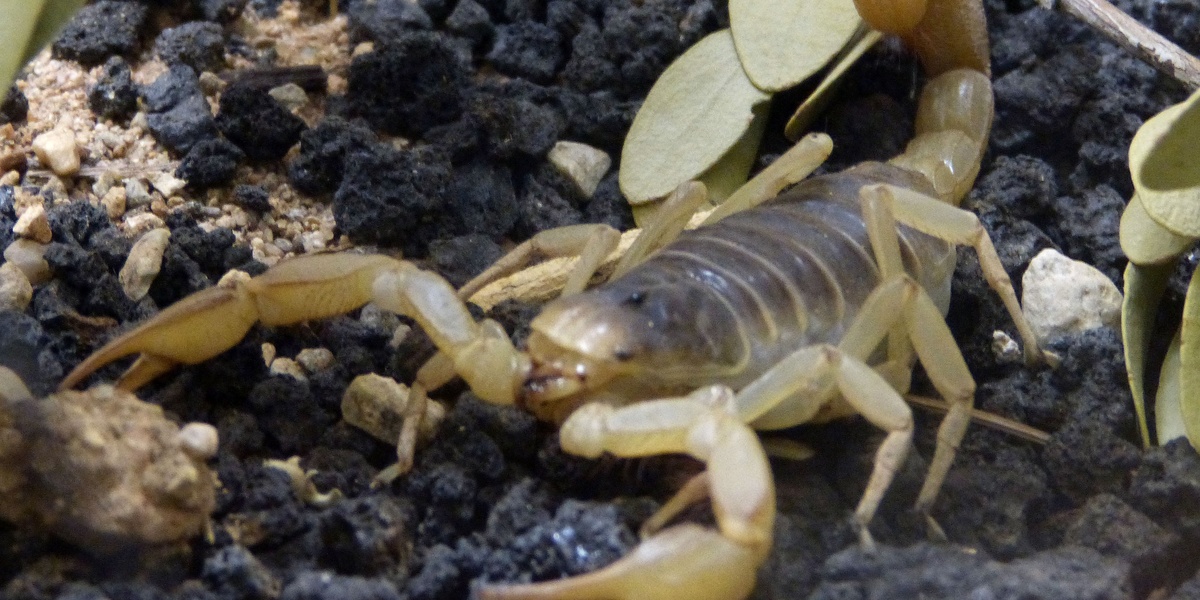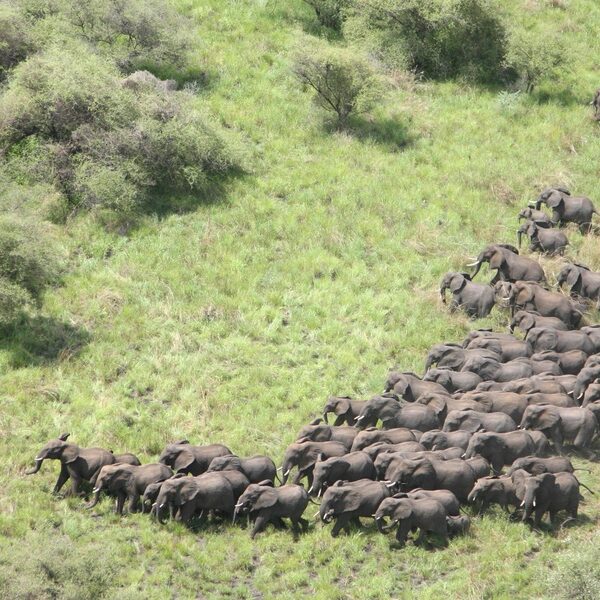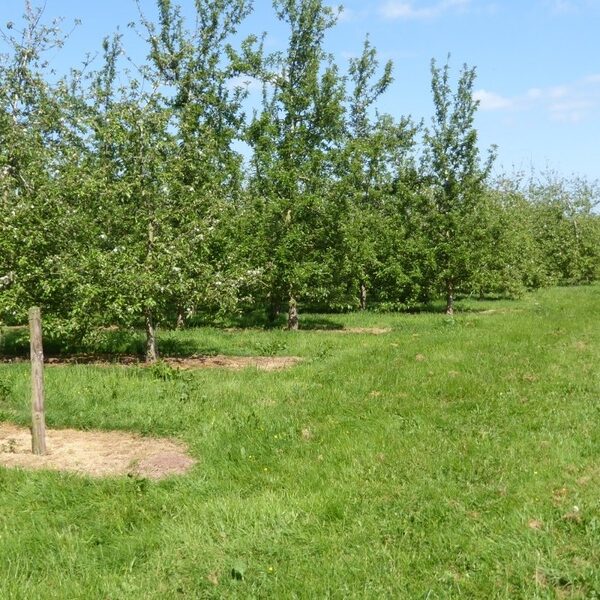Desert landscapes hide a surprising variety of eight‑legged and many‑limbed life adapted to heat, sand and scarce water. These creatures are active hunters, scavengers and web‑builders, quietly shaping food webs across dunes, scrub and rocky flats.
There are 33 Desert Arachnids, ranging from the communal African social spider to the solitary Western black widow; for each species the list below shows Scientific name,Range (regions),Venom risk so you can quickly compare distribution and potential hazards—you’ll find below.
Are desert arachnids dangerous to people?
Most desert arachnids pose little risk and help control pests; only a few species have medically significant venom, and bites are usually local pain or swelling. If you suspect a bite from a known dangerous species (for example a widow), seek medical advice, keep the person calm, and note the animal’s appearance for identification.
How can I identify which desert arachnid I’ve found?
Look at body shape (spiders vs. scorpions), presence of pincers or a tail, size, color patterns and behavior (webs vs. active hunting), and photograph the specimen from several angles. Compare those details with the Scientific name,Range (regions),Venom risk entries you’ll find below or consult a local extension or field guide for confirmation.
Desert Arachnids
| Common name | Scientific name | Range (regions) | Venom risk |
|---|---|---|---|
| Arizona bark scorpion | Centruroides sculpturatus | Sonoran Desert (SW USA, N Mexico); rock crevices, walls, homes | High — potent neurotoxin; medical attention advised |
| Desert hairy scorpion | Hadrurus arizonensis | Sonoran and Mojave deserts (SW USA); sandy soils, burrows under rocks | Low — painful but rarely life-threatening |
| Deathstalker | Leiurus quinquestriatus | North African, Sinai, Arabian deserts; sandy flats and rock crevices | High — extremely potent venom; medical attention essential |
| Fat-tailed scorpion | Androctonus australis | Sahara and Arabian deserts; under rocks, in crevices and burrows | High — highly toxic, can be fatal without care |
| African thick-tailed scorpion | Parabuthus transvaalicus | Southern African arid plains and Kalahari; open, sandy ground | High — venomous and can spray venom; dangerous |
| Indian red scorpion | Hottentotta tamulus | Arid and semi-arid regions of India; under stones and in burrows | High — medically significant, can cause systemic effects |
| Striped scorpion | Vaejovis spinigerus | Southwestern US deserts (Mojave, Sonoran); rock crevices, under bark | Low — mild venom, localized pain typical |
| Baja bark scorpion | Centruroides exilicauda | Baja California and Sonoran Desert; crevices, human structures | Moderate — venomous, variable effects; treat children cautiously |
| Mediterranean common scorpion | Buthus occitanus | Mediterranean and semi-arid N Africa, Canary Islands; rocky scrub | Moderate — can cause severe pain and systemic signs in some |
| Saharan burrowing scorpion | Leiurus jordanensis | Levant and Sinai semi-deserts; sandy dunes and rock shelters | High — similar risks to related species, seek care |
| Desert tarantula | Aphonopelma chalcodes | Sonoran and Chihuahuan deserts (SW USA); burrows under rocks | Low — venom mild; bite painful like a bee sting |
| Western black widow | Latrodectus hesperus | Western North American deserts; under rocks, woodpiles, shaded structures | Moderate — neurotoxic venom; medical care recommended |
| Brown widow | Latrodectus geometricus | Arid and urban edges worldwide, sheltered niches around homes | Moderate — venom neurotoxic but often milder than black widow |
| Six-eyed sand spider (sand recluse group) | Sicarius spp. | Sahara, Arabian, parts of S. America deserts; sand-burrowing habitats | Moderate — necrotic venom in related species; bites rare |
| African social spider | Stegodyphus dumicola | Arid shrublands of southern Africa; communal webs in shrubs | Low — venom mild; bites uncommon to humans |
| Flattie spider (wall crab) | Selenops spp. | Dry rocky deserts worldwide; flat rock faces, under bark | Low — venom mild; quick, flattened hunter often seen on walls |
| Desert camel spider (wind scorpion) | Eremobates spp. | North American deserts; sandy flats, under rocks at night | Low — non-venomous; powerful chelicerae can inflict painful bite |
| Galeodes camel spider | Galeodes arabs | Middle Eastern deserts; sand and stony plains, nocturnal hunter | Low — non-venomous; strong jaws cause painful bites |
| Rhagodes camel spider group | Rhagodes spp. | Central Asian and Middle Eastern arid zones; rocky, sandy habitats | Low — non-venomous; prominent chelicerae, fast-moving predator |
| Giant vinegaroon (whip scorpion) | Mastigoproctus giganteus | Sonoran and Chihuahuan deserts (SW USA); under logs, rock crevices | Low — non-venomous; sprays acetic acid that irritates skin |
| Desert whip spider group | Paraphrynus spp. | Mexican and SW US rocky deserts and caves; crevices, under bark | Low — non-venomous amblypygids; intimidating appearance only |
| Saharan wolf spider | Arctosa spp. | Saharan edges and Mediterranean deserts; sandy flats, dune bases | Low — venom mild; typically avoids humans |
| Desert sac spider | Cheiracanthium spp. | Arid regions worldwide in shrubs and human structures | Moderate — venom can cause localized necrosis in some reports |
| Sand-dwelling jumping spider | Menemerus bivittatus | Open dry habitats and urban edges in warm arid regions | Low — venom mild to humans; bite rare |
| Burrowing wolf spider | Geolycosa spp. | Dry grassland and desert margins worldwide; burrows in soil | Low — venom mild; bite rarely problematic |
| Saharan sand scorpion (local species) | Buthus spp. | North African and Middle Eastern deserts; under stones, in crevices | Moderate — venom can cause intense pain; medical care sometimes needed |
| North American desert scorpion genus | Centruroides spp. | Arid and semi-arid North America; crevices, human structures | Moderate — species vary; some medically significant |
| Desert soft tick (sand tampan) | Ornithodoros savignyi | Sahara, Arabian Peninsula and surrounding deserts; rodent burrows, livestock areas | Moderate — painful bite; can transmit pathogens to livestock and humans |
| African soft tick | Ornithodoros moubata | Dry savanna and arid zones in Africa; caves and rodent nests | Moderate — relapsing fever vector in some areas; bite painful |
| Camel tick | Hyalomma dromedarii | Sahara, Arabian, Central Asian deserts; on camels, livestock, ground | Moderate — transmits pathogens; painful attachment and feeding |
| Chigger (trombiculid mite larvae) | Eutrombicula alfreddugesi | Dry scrub and grassland edges in N America, including arid zones | Low — larval feeding causes itchy lesions, not venomous |
| Scabies mite | Sarcoptes scabiei | Worldwide, including arid human settlements and nomadic settings | Low — parasitic mite causing intense itching, not venomous |
| Desert black scorpion (Southern Africa) | Parabuthus capensis | Southern African arid regions and Karoo; rocky outcrops and sandy soils | High — venomous, medically important in region |
Images and Descriptions

Arizona bark scorpion
Small, pale scorpion about 2–3 inches long with slender tail and pincers. Climbs walls and hides in crevices or homes. Sting causes intense pain, numbness, possible systemic symptoms; dangerous for children and older adults, seek medical care.

Desert hairy scorpion
Large, hairy scorpion up to 5–6 inches long with yellow-orange body and strong pincers. Lives in burrows in sandy soils and active at night. Sting is painful but seldom medically serious for healthy adults.

Deathstalker
Medium-sized, pale yellow scorpion with thin pincers and a slender tail. Found in arid sands and rocky desert; famous for powerful neurotoxic venom. Envenomation can be life-threatening, especially to children.
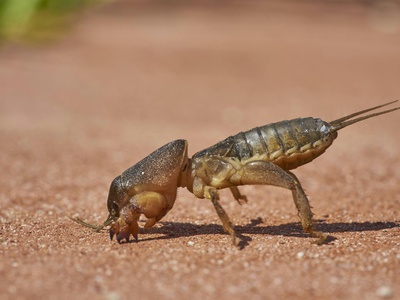
Fat-tailed scorpion
Robust, dark scorpion 2–4 inches long with thick tail and stout pincers. Prefers hot, sandy habitats and sheltering under stones. Venom can cause severe systemic signs; seek urgent medical treatment.
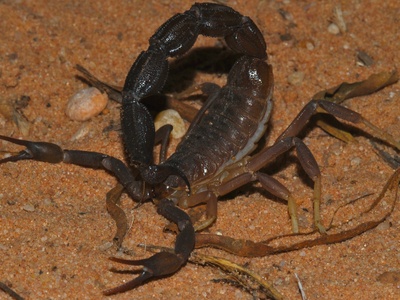
African thick-tailed scorpion
Large, heavy-bodied scorpion with thick tail and strong sting. Active on open ground at night. Capable of spraying venom; envenomation is medically significant in many cases.
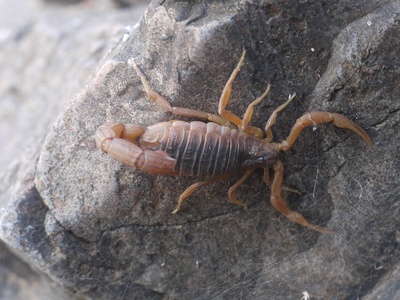
Indian red scorpion
Medium scorpion with reddish coloration and strong tail. Common in dry agricultural and scrubland. Sting can produce severe pain, cardiovascular symptoms; notable cause of serious scorpion envenoming in South Asia.
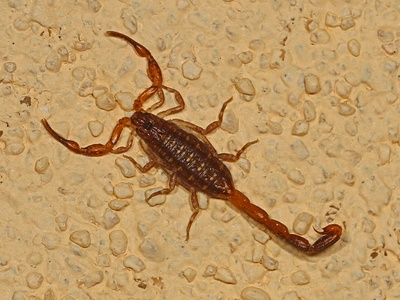
Striped scorpion
Small to medium scorpion with dark body and faint striping, approximately 1.5–2.5 inches. Prefers rocky microhabitats and crevices. Stings cause local pain and swelling but rarely systemic illness.
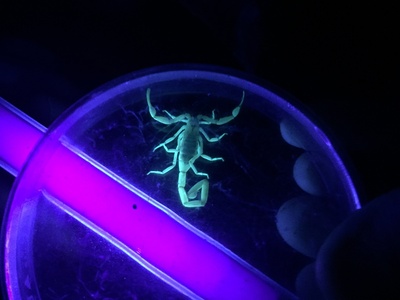
Baja bark scorpion
Pale to tan bark scorpion about 2–3 inches long that climbs and often enters buildings. Sting can be painful with possible systemic symptoms in sensitive people; prompt evaluation recommended for young or ill patients.
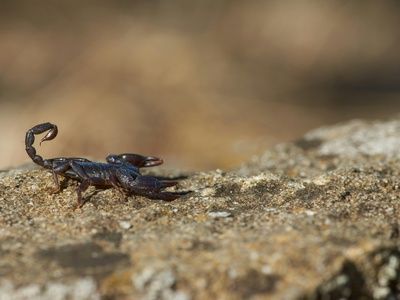
Mediterranean common scorpion
Yellowish-brown scorpion common in dry Mediterranean scrub and rocky soils. Moderate size with typical buthid build. Stings are painful and occasionally medically significant depending on individual sensitivity.
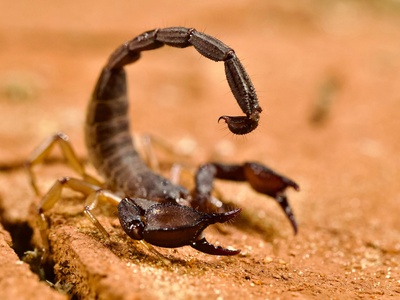
Saharan burrowing scorpion
Pale, slender scorpion adapted to sandy desert habitats, hides in shallow burrows or under stones. Neurotoxic venom can produce severe symptoms; vulnerable individuals require medical attention.
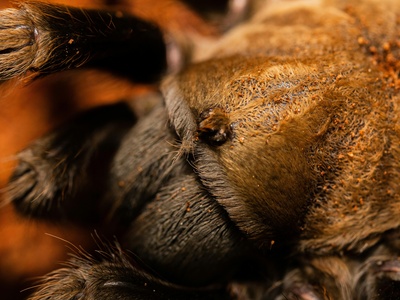
Desert tarantula
Large, hairy tarantula with orange-brown carapace and dark abdomen, legspan up to 4–5 inches. Lives in burrows and closed to human encounters. Bites cause local pain; hairs may irritate skin or eyes.
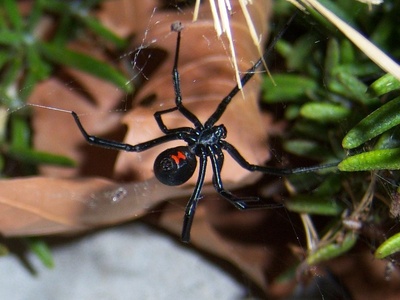
Western black widow
Shiny black spider with red hourglass on abdomen, small body with long legs. Often found in sheltered, human-associated spots in desert. Bites can cause severe cramping and systemic effects; antivenom available.

Brown widow
Smaller widow with mottled brown pattern and orange hourglass. Favors man-made structures, under eaves and debris. Bites produce pain and muscle symptoms; rarely life-threatening.

Six-eyed sand spider (sand recluse group)
Flat, sand-colored spider that buries in loose sand with only eyes exposed. Equipped with stout legs and six eyes. Bites are uncommon but can cause local necrosis in some species.
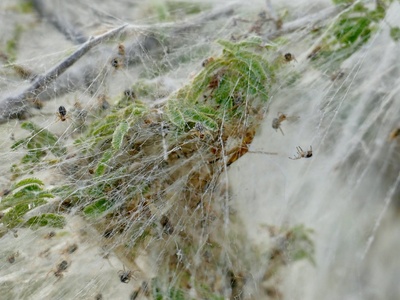
African social spider
Small to medium brown spider living in communal silky nests over shrubs. Builds conspicuous webs in dry savanna and scrub. Bites are rarely serious; notable for striking social behavior and cooperative prey capture.

Flattie spider (wall crab)
Very flat, crab-like spiders that scuttle rapidly across rock and crevice surfaces. Typically 0.5–1 inch legspan. Found on sunny rock faces in deserts; harmless to humans, bite rare and mild.
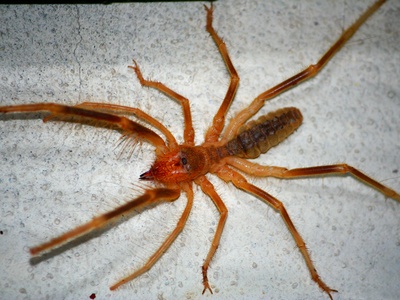
Desert camel spider (wind scorpion)
Fast, stocky solifuge with large jaw-like chelicerae and many legs. Active nocturnally hunting insects on desert ground. Not venomous, but bites can be painful and may become infected.
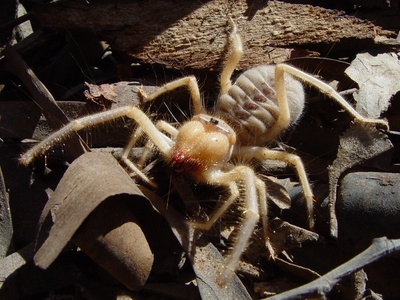
Galeodes camel spider
Large, sandy-colored solifuge with formidable chelicerae and rapid bursts of speed. Hunts insects and small animals at night on open desert ground. Bites are mechanically painful but not due to venom.
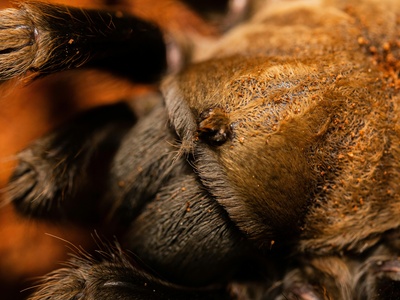
Rhagodes camel spider group
Solifuge genus common in Asian deserts, recognizable by strong jaws and active nocturnal hunting. Lives under stones and in shallow burrows. Bites are painful but not venomous.

Giant vinegaroon (whip scorpion)
Dark, robust arachnid up to 3–4 inches body length with whip-like tail. Emits vinegar-smelling spray when threatened and uses pedipalps to capture prey. Harmless venom-wise; pinch and spray can irritate.
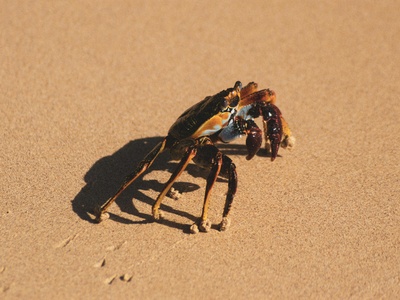
Desert whip spider group
Flat, broad-bodied amblypygids with long, spiny front legs used like sensors. Live in rock crevices and cave entrances. Harmless to humans; pinch is unlikely and no venom.

Saharan wolf spider
Ground-dwelling wolf spiders that run and hunt prey on sand surfaces. Robust, cryptic coloration and excellent eyesight. Bites produce local pain and swelling but are rarely dangerous.
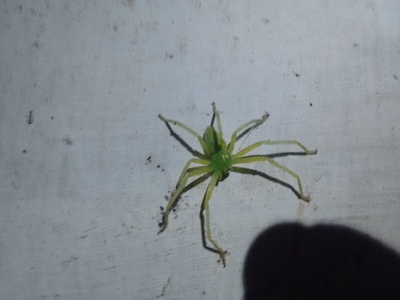
Desert sac spider
Small, pale nocturnal hunters creating silk sacs in daytime retreats. Often found in dry scrub and houses near deserts. Bites cause short-lived pain; occasional reports of skin necrosis.

Sand-dwelling jumping spider
Compact, agile jumper with large forward-facing eyes and patterned abdomen. Prefers sun-exposed rocks and walls in desert margins. Bites are uncommon and usually cause minor irritation.
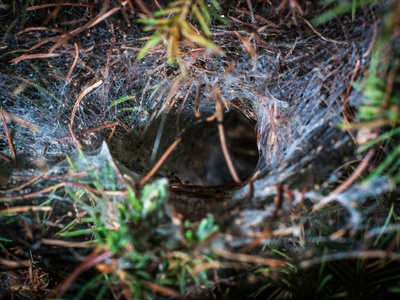
Burrowing wolf spider
Large ground wolf spider that digs vertical burrows with silk-lined entrances. Solitary ambush hunter active at night. Bites are painful but seldom medically significant for healthy adults.
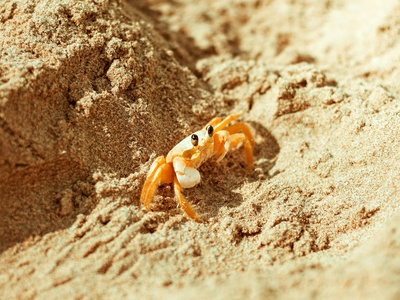
Saharan sand scorpion (local species)
Small to medium yellowish scorpions common in hot desert regions. Slim pincers and potent sting typical of buthid group. Envenomation produces severe pain and occasionally systemic signs.
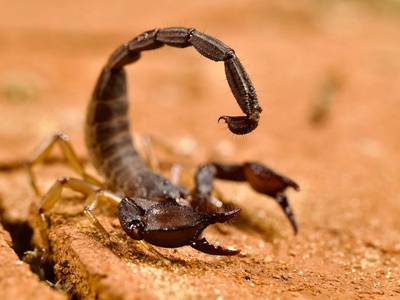
North American desert scorpion genus
Bark scorpion group including several desert-adapted species. Slim, climbing scorpions often enter homes. Venom potency varies by species; treat suspected severe reactions promptly.

Desert soft tick (sand tampan)
Small, leathery soft tick living in sandy rodent burrows and near livestock. Feeds rapidly and can cause painful, repeated bites; vector potential for local diseases in arid regions.

African soft tick
Soft tick with rapid feeding, common in dry rodent nests and cave systems. Known vector of relapsing fever bacteria in parts of Africa; human bites can be alarming and painful.
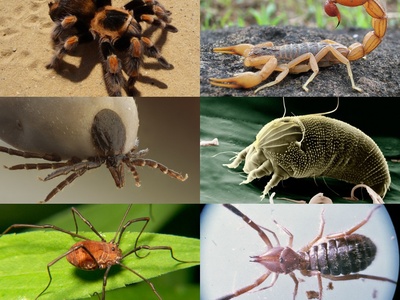
Camel tick
Large hard tick adapted to desert ungulates, often on camels and livestock. Strong runner, can survive extreme heat. Can transmit tick-borne diseases to animals and occasionally humans.

Chigger (trombiculid mite larvae)
Tiny red-orange larval mites that attach to skin and feed briefly, causing intensely itchy welts. Common in vegetation at desert margins and disturbed ground; irritation is the main concern.

Scabies mite
Microscopic burrowing mite that infests mammal skin, producing severe itching and rash. Persists in dry conditions where close contact occurs. Medical treatment clears infestation; hygiene reduces spread.

Desert black scorpion (Southern Africa)
Medium to large scorpion with stout tail and potent venom. Active on open ground at night and found around human habitation in dry areas. Envenoming can be severe; medical care often required.
